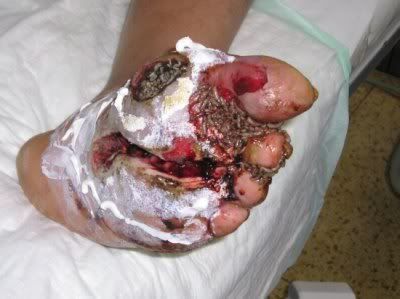
Maggots have been known for centuries to help heal wounds. Military surgeons noted that soldiers whose wounds became infested with maggots had better outcomes than those not infested. William Baer, while at Johns Hopkins University in Baltimore, Maryland, may have been the first in the Northern Hemisphere to have intentionally applied larvae to wounds in order to induce wound healing. During the late 1920's, he identified specific species, raised them in the laboratory, and used their larvae to treat several children with osteomyelitis and soft tissue infections. He presented his findings at a surgical conference in 1929. Two years later, after treating 98 children, his findings were published posthumously.
MDT was successfully and routinely performed by thousands of physicians throughout the 1930’s, but soon it was supplanted by the new antibiotics and surgical techniques that came out of World War II. Maggot therapy was occasionally used during the 1970's and 1980's, but only when antibiotics, surgery, and modern wound care failed to control the advancing wound.
The first modern clinical studies of maggot therapy were initiated in 1989, at the Veterans Affairs Medical Center in Long Beach, CA, and at the University of California, Irvine, to answer the following questions:
"Is maggot therapy still useful today?"
"Should maggot therapy be used as an adjunct to other treatments, not merely as a last resort?"
"How does maggot therapy compare to other treatments at our disposal?"
The results of those controlled comparative clinical trials and the many studies and reports that followed, indicate that MDT is still useful today as a safe and effective treatment tool for some types of wounds. Those studies also demonstrated that there is no reason to withhold MDT until all other modalities have been exhausted, nor use it only as a “last resort.” Indeed, while published accounts of “pre-amputation MDT” show a limb salvage rate of over 40%, the success of MDT when used earlier in the course of treatment (say, as a 2nd or 3rd or 4th line treatment) is even more dramatic.
Current status of maggot therapy
In 1995, a handful of doctors in 4 countries were using MDT. Today, any physician in the U.S. can prescribe maggot therapy. Over 4,000 therapists are using maggot therapy in 20 countries. Approximately 50,000 treatments were applied to wounds in the year 2006.
In January 2004, the U.S. Food and Drug Administration (FDA) began regulating medicinal maggots, and allowed the production and marketing of one particular strain of Phaenicia sericata larvae marketed under the brand name Medical Maggots (TM). In February, 2004, the British National Health Service (NHS) permitted its doctors to prescribe maggot therapy. Patients no longer have to be referred to one of a few regional wound-specialty hospitals to get maggot treatments.
The BioTherapeutics, Education & Research Foundation was established in 2003 for the purpose of supporting patient care, education, and research in maggot therapy and the other forms of symbiotic medicine (diagnosing and/or treating diseases with live animals, such as maggot therapy, leech therapy, honey bee therapy, pet therapy & sniffer dogs, ichthiotherapy, bacteriotherapy etc).
Biology of flies and maggots
Maggots are fly larvae, or immature flies, just as caterpillars are butterfly or moth larvae. Maggots do not appear all by themselves ("de novo"), as was believed 150 years ago; they hatch from eggs, laid by adult female flies.
Not all species of flies are safe and effective as medicinal maggots. There are thousands of species of flies, each with its own habits and life cycle. Some fly larvae feed on plants or animals, or even blood (i.e., mosquitoes). Others feed on rotting organic material.
Those flies whose larvae feed on dead animals will sometimes lay their eggs on the dead parts (necrotic or gangrenous tissue) of living animals. When maggots are infesting live animals, that condition is called “myiasis.” Some of those maggots will feed only on dead tissue, some only on live tissue, and some on live or dead tissue. The flies used most often for the purpose of maggot therapy are "blow flies" (Calliphoridae); and the species used most commonly is Phaenicia sericata, the green blow fly.
A diagram and photograph of a typical blow fly life cycle appears below

Advantages and disadvantages of maggot debridement therapy (“MDT")
Efficacy, as demonstrated in several small but significant controlled clinical studies.
Takes about 15-30 minutes to apply a secure dressing to keep the maggots in place.
Excellent safety record.
Maggots are highly perishable and should be used within 24 hours of arrival.
Simple enough that non-surgeons can use it to provide thorough debridement when surgery is not available or is not the optimal choice. This means that it is also possible to provide surgical quality debridement as an outpatient or in the home.
Low cost of treatment
Thus, Maggot therapy is an effective, accepted method of treating chronic, non-healing wounds. Only specially selected, tested, disinfected larvae are applied to the wound surface and covered with a dressing that prevents the larvae from escaping. They are easily and completely removed 2 or 3 days later. Sometimes the wound is completely cleaned by then; sometimes additional treatments may be necessary. After maggot therapy, the wound may be clean enough to close, cover, graft, or flap. Your doctor will be able to suggest the best treatment to follow.
Maggot therapy is also known as Maggot Debridement Therapy with short form (MDT). It is a treatment in cleaning wounds to heal quickly. Modern medical science has brought maggot therapy, using maggots to wash cuts, from out of the pages of history to the modern hospital environment. Research done in France found that maggots can clean wounds quicker than surgery in patients with seeping cuts. Source of article: French study finds maggot therapy works as well as surgery
ReplyDelete